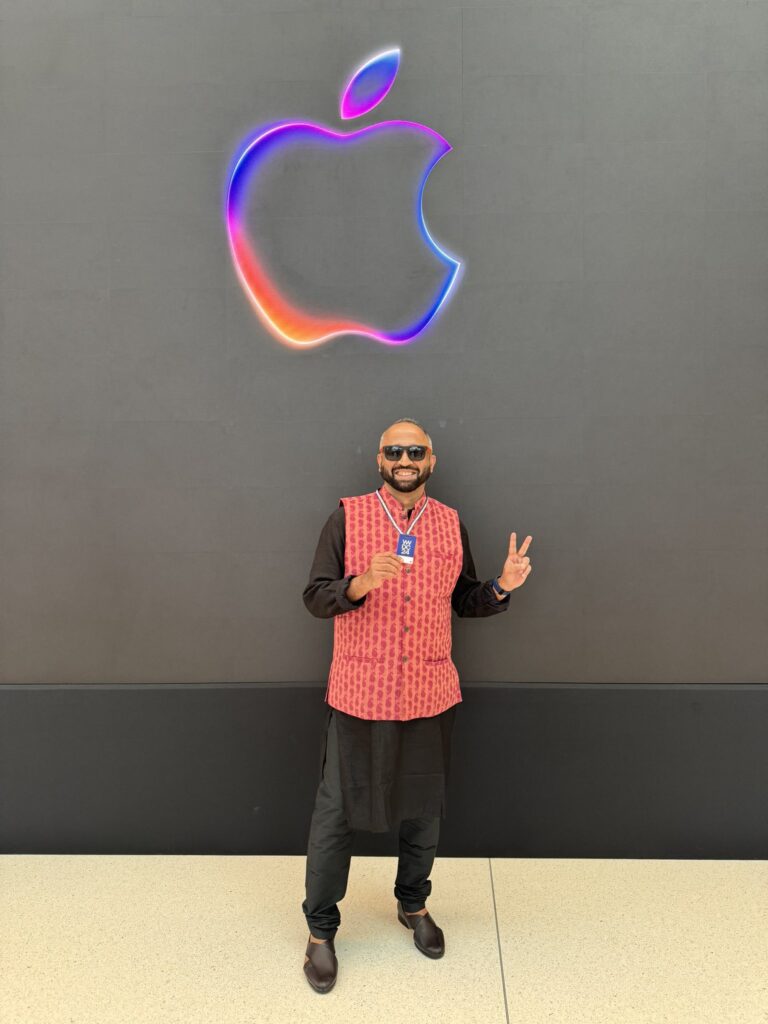I spent this week at Apple’s annual Worldwide Developer Conference (WWDC 2024) at Apple Park. The WWDC 2024 marked a pivotal moment for Apple.
Since the launch of the iPhone in 2007, nearly 17 years ago, Apple now seems poised for its next major shift with AI – the ‘Apple Intelligence’. With Apple Intelligence, Apple unveiled its vision for integrating Artificial Intelligence (AI)/ Generative Artificial Intelligence (GAI) across its product ecosystem.

The key feature, Apple Intelligence provides an array of AI-based capabilities promising personalized AI services while keeping sensitive data secure. Apple Intelligence acts as a personal assistant, processing user data such as relationships, contacts, messages, emails, and calendar events to streamline tasks like finding old photos, attaching relevant files to emails, and prioritizing notifications. The system aims to assist users with various tasks on their devices, including texting, communication, document editing, and email summarization, leveraging the context provided by the device’s semantic index and powered exclusively by foundation models trained by Apple.
Apple’s approach emphasizes a strong commitment to privacy.
At the WWDC 2024, Apple dived-deep into both the on-device models and those running in Private Cloud Compute (PCC). All models are trained entirely by Apple, ensuring user data remains secure. Apple’s privacy-focused system will first attempt to fulfill AI tasks locally on the device itself. If any data is exchanged with cloud services, it will be encrypted and deleted afterward. The process, termed Private Cloud Compute, will be subject to verification by independent security researchers.
Unlike other companies that collect and store large amounts of personal data, Apple states that any personal data passed to the cloud will be used only for the AI task and will not be retained or accessible for debugging or quality control after the model completes the request.
Private Cloud Compute (PCC)
Apple’s PCC service addresses privacy and data security concerns traditionally associated with cloud services. PCC provides the computational power needed for Apple’s generative AI models without compromising user privacy. This infrastructure is essential for tasks requiring more processing power than Apple devices can supply. The PCC is powered by a network of Apple Silicon servers located in US data centers, running Apple’s generative AI models remotely when tasks demand more computational power than an Apple device can provide. Many Apple Intelligence tasks will run on the device itself, with PCC providing additional power when necessary. Requests requiring PCC are routed through an Oblivious HTTP (OHTTP) relay operated by an independent third party, concealing the user’s IP address. Only the data relevant to the task is sent to the PCC servers, ensuring no additional information is stored or accessible. This method guarantees no data retention, privileged access, or user identity exposure.
Security Measures
Apple has implemented extensive security measures to protect PCC users. The system is designed to prevent data compromise without breaching the entire PCC system, including measures against remote attacks and physical access to data centers. Apple has made the system open to independent security and privacy reviews, enhancing its credibility. The hardware is secured with built-in protections such as Secure Enclave and Secure Boot. Apple has also introduced Swift on Server, a platform that ensures memory safety and limits potential attack surfaces.
Responsible AI and User Empowerment
Apple’s AI tools are developed with a strong focus on user security and ethical use, adhering to principles outlined on their site:
• Empower users with intelligent tools.
• Represent users authentically.
• Design with care to prevent misuse.
• Protect user privacy with on-device processing and secure infrastructure.
Apple’s AI models are trained on licensed data and publicly available data collected by AppleBot, ensuring responsible and ethical AI development.
What about Apple Intelligence and ChatGPT Integration?
The ChatGPT integration supplements Apple Intelligence by providing broader, general world knowledge, including information about history, current events, and other topics not directly related to personal data. Users can opt-in to have Siri forward queries to ChatGPT or assist in writing documents within Apple apps. This integration is expected to extend to other third-party AI models, offering a seamless interface for users to access comprehensive AI capabilities. When enabled, ChatGPT is used selectively for broader queries. For example, asking Siri for decorating ideas based on a photo utilizes ChatGPT’s capabilities for general world knowledge. Importantly, no additional data from the semantic index is included in these requests, ensuring personal details remain private. In the default logged-out experience, OpenAI, which powers ChatGPT, is prohibited from storing or training on any data transmitted through Apple’s systems. Users can choose to log in and connect their OpenAI account to retain query history, but this shifts data privacy responsibilities to OpenAI’s policies.
Real-World Applications
At the WWDC 2024, Apple showcased several real-world applications of Apple Intelligence. Instead of scrolling through messages for a podcast, users could ask Siri to find and play it. In another scenario, an email about a rescheduled work meeting could prompt the phone to find a PDF with performance details, predict local traffic, and notify the user if they will make it on time. These capabilities will extend beyond apps made by Apple, allowing developers to tap into Apple’s AI as well.
In Conclusion
This year’s WWDC 2024 was a seminal moment. Apple will soon release beta versions of its Apple Intelligence features, starting with the iPhone 15 and the new macOS Sequoia, compatible with Macs and iPads with M1 chips or newer. These developments are expected to establish new standards for personal intelligence and cloud computing, promising enhanced security and functionality in the digital landscape.



